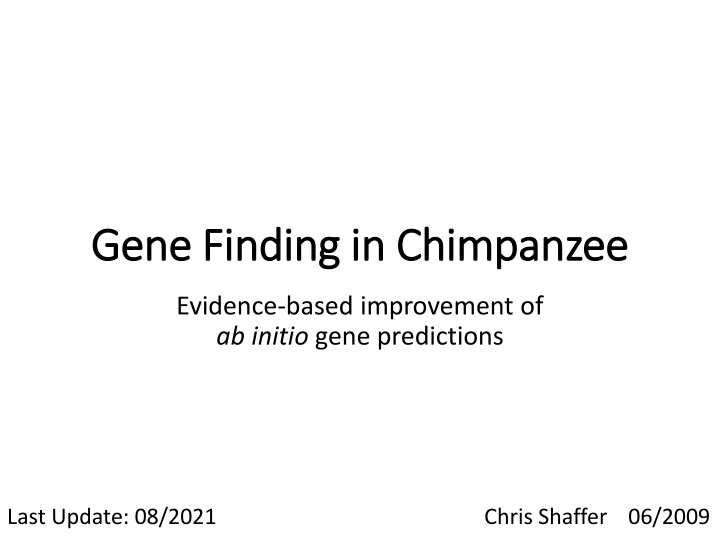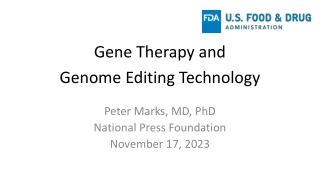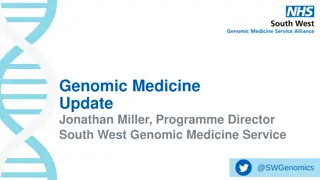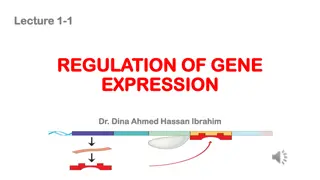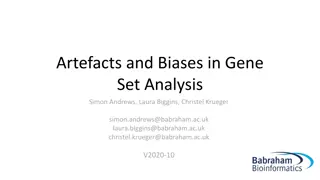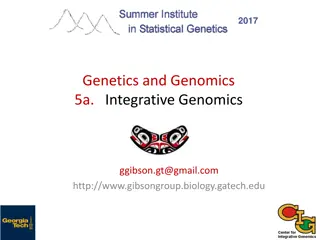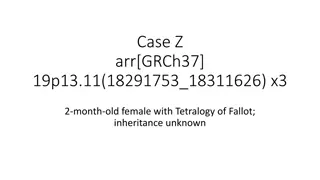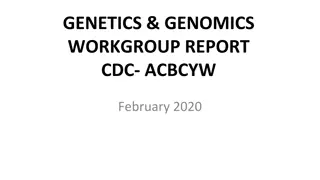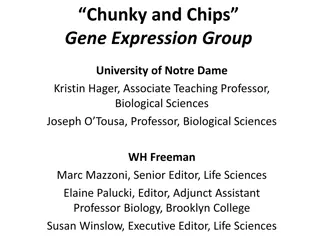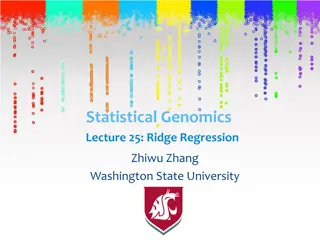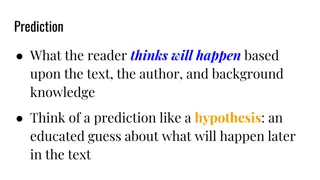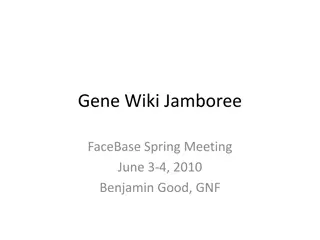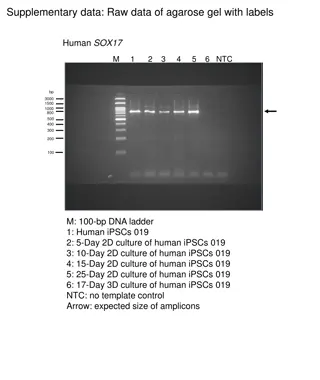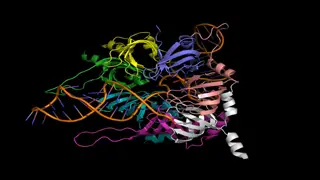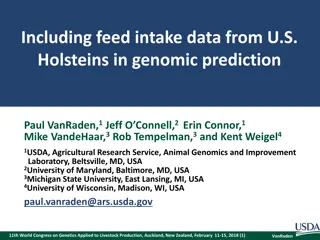Enhancing Gene Predictions Based on Chimpanzee Genomic Analysis
Dive into evidence-based improvement of gene predictions in chimpanzees, focusing on ab initio predictions and utilizing various computational and cognitive skills to annotate mammalian genomes. Explore basic gene structures, motif information, and strategies to refine gene models for accurate annotations.
Download Presentation

Please find below an Image/Link to download the presentation.
The content on the website is provided AS IS for your information and personal use only. It may not be sold, licensed, or shared on other websites without obtaining consent from the author.If you encounter any issues during the download, it is possible that the publisher has removed the file from their server.
You are allowed to download the files provided on this website for personal or commercial use, subject to the condition that they are used lawfully. All files are the property of their respective owners.
The content on the website is provided AS IS for your information and personal use only. It may not be sold, licensed, or shared on other websites without obtaining consent from the author.
E N D
Presentation Transcript
Gene Finding in Chimpanzee Gene Finding in Chimpanzee Evidence-based improvement of ab initio gene predictions Last Update: 08/2021 Chris Shaffer 06/2009
Chimp Analysis Chimp Analysis Prerequisites (BLAST exercises): o Detecting and Interpreting Genetic Homology o Using mRNA and EST Evidence in Annotation Learning objectives: o Exposure to mammalian genomes o Practice computational and cognitive skills Two parts: o BAC analysis in class worksheet o Chimp chunks selected regions of the chimp genome are annotated by groups of 2 3 students; ends with paper and presentation
Agenda Agenda Abridged version of Bio 4342 lecture (next 5 slides) Work together on one chimp feature from BAC analysis Optional work on chimp chunk individually with help from TA s
Basic Strategy for Annotation Basic Strategy for Annotation Use ab initio prediction to focus attention on genomic features (areas) of interest 80% failure rate; where are the mistakes? Add as much other evidence as you can to refine the gene model and support your conclusion What other evidence is there? 1. Basic gene structure 2. Motif information 3.BLAST homologies: nr, protein, ESTs 4. Other species or other proteins
Chimpanzee Annotation Chimpanzee Annotation 1. Basic gene structure o Only ~15% of known mammalian genes have one exon o Many pseudogenes are mRNAs that have retrotransposed back into the genome; many of these will appear as a single exon genes o Increase vigilance for signs of a pseudogene when considering any single exon gene o Alternatively, there may be missing exons
Chimpanzee Annotation Chimpanzee Annotation 2. Motif information o Genscan uses statistical methods to predict genes, will tag all apparent ORFs of sufficient length o Since genomes are very large, statistical methods will give some false positives Sequence looks like a gene simply by chance o If the predicted gene has protein motifs found in other proteins, it is much less likely to be a false positive and more likely to be a real gene or a real pseudogene
Chimpanzee Annotation Chimpanzee Annotation 3. BLAST homology: nr, protein, EST o Homology to known proteins argues against false positive o Mammals have many gene families and many pseudogenes Both can show high sequence similarity to your predicted gene o Consider length and percent identity when examining alignments Human vs. chimp orthologs should differ by <1% Most paralogs or homologs will differ by more than this o Without good EST or RNA-Seq evidence you can never be sure; make your best guess and be able to defend it
Chimpanzee Annotation Chimpanzee Annotation 4. Other species or other proteins o For any similarity hit, look for even better hits elsewhere in the genome Paralogs and pseudogenes will look similar but will usually have an even better hit somewhere else o If you are convinced you have a gene and it is a member of a multi-gene family, be sure to pick the right ortholog o Look at synteny with properly distant species (mouse or rat) Evidence for a transposition suggests a pseudogene
Chimp BAC Analysis Chimp BAC Analysis Worksheet in your folder, follow along, ask for help Genscan was run on the repeat-masked BAC using the vertebrate parameter set (GENSCAN_ChimpBAC.html) o Genscan is a good ab initio gene finder o Predicts 8 genes within this BAC o By default, Genscan also predicts promoter and poly-A sites; however, these are generally unreliable o Output consists of map, summary table, peptide and coding sequences of the predicted genes
Chimp BAC Analysis Chimp BAC Analysis Analysis of Gene 1 (423 coding bases): o Use the predicted peptide sequence to evaluate the validity of Genscan prediction blastp of predicted peptide against the nr database o Typically uses the NCBI BLAST page: https://blast.ncbi.nlm.nih.gov/Blast.cgi Click on the Protein BLAST image Select the blastp algorithm Search against the nr database o For the purpose of this tutorial, open blastpGene1.txt
Interpreting Interpreting blastp blastp Output Output Many significant hits to the nr database that cover the entire length of the predicted protein Do not rely on hits that have accession numbers starting with XP_ o XP_ indicates RefSeq without experimental confirmation o NP_ indicates RefSeq that has been validated by the NCBI staff Click on the Description for the best curated RefSeq hit in the blastp output (NP_001288157.1) o Indicates hit to human HMGB3 protein
Investigating HMGB3 Alignment Investigating HMGB3 Alignment The full HMGB3 protein has length of 200 aa o However, our predicted peptide only has 140 aa Possible explanations: o Genscan mispredicted the gene Missed part of the real chimp protein o Genscan predicted the gene correctly Pseudogene that has acquired an in-frame stop codon Functional protein in chimp that lacks one or more functional domains when compared to the human version Best Source: further evidence from the human genome
Analysis Using the Analysis Using the UCSC Genome Browser UCSC Genome Browser Go back to Genscan output page and copy the first predicted coding sequence Navigate to the UCSC Genome Browser at https://genome.ucsc.edu Click on the BLAT link (under Our tools ) o Select the Human genome o Select the Mar. 2006 (NCBI36/hg18) assembly o Paste the coding sequence into the text box o Click Submit
Human Human BLAT BLAT Results Results Predicted sequence matches to many places in the human genome o Top hit shows sequence identity of 99.1% between our sequence and the human sequence o Next best match has identity of 93.6%, below what we expect for human / chimp orthologs (98.5% identical) Click on browser for the top hit (on chromosome 7) o The genome browser for this region in human chromosome 7 should now appear
Human Human UCSC Genome Browser UCSC Genome Browser Zoom out 3x to get a broader view There are no known genes in this region o Only evidence is from hypothetical genes predicted by SGP and Genscan o SGP predicted a larger gene with two exons o There are also no known human mRNAs or human ESTs in the aligned region o However, there are ESTs from other organisms
Investigate Partial Match Investigate Partial Match Go to GenBank record for the human HMGB3 protein (using the BLAST result) Click on the FASTA link to obtain the sequence Go back to the BLAT search page to use this sequence to search the human genome assembly o Mar. 2006 (NCBI36/hg18)
BLAT BLAT Search of Human HMGB3 Search of Human HMGB3 Notice the match to part of human chromosome 7 we observed previously is only the 7th best match o Identity of 88.8% o Consistent with one of our hypotheses that our predicted protein is a paralog Click on browser to see corresponding sequence on human chromosome 7 o BLAT results overlap Genscan prediction but extend both ends o Why would Genscan predict a shorter gene?
Examining Alignment Examining Alignment Now we need to examine the alignment: o Go back to previous page and click on details The alignment looks good except for a few changes o However, when examining some of the unmatched (black) regions, notice there is a TAG a stop codon Examine the side-by-side alignment to confirm that the TAG sequence is an in-frame stop codon on human chromosome 7 o This in-frame stop codon caused Genscan to predict a shorter gene
Confirming Pseudogene Confirming Pseudogene Side-by-side alignment color scheme o Lines = match o Green = similar amino acids o Red = dissimilar amino acids We noticed a red X (stop codon) aligning to a Y (tyrosine) in the human sequence
Confirming Pseudogene Confirming Pseudogene Alignment after stop codon showed no deterioration in similarity suggest our prediction is a recently retrotransposed pseudogene To confirm hypothesis, go back to BLAT results and get the top hit (100% identity on chromosome X) The real HMGB3 gene in human has four coding exons!
Conclusions Conclusions Based on evidence accumulated: o As a cDNA, the four-exon HMGB3 gene was retrotransposed o It then acquired a stop codon mutation prior to the split of the chimpanzee and human lineages o The retrotransposition event is relatively recent Pseudogene still retains 88.8% sequence identity to the source protein
Questions? Questions?
ab initio ab initio Gene Finders Gene Finders Examples: o Glimmer for prokaryotic gene predictions (S. Salzberg, A. Delcher, S. Kasif, and O. White 1998) o Genscan for eukaryotic gene predictions (Burge and Karlin 1997) We will use Genscan for our chimpanzee and Drosophila annotations
Genscan Genscan Gene Model Gene Model Genscan considers the following: o Promoter signals o Polyadenylation signals o Splice signals o Probability of coding and non-coding DNA o Gene, exon and intron length Chris Burge and Samuel Karlin, Prediction of Complete Gene Structures in Human Genomic DNA, JMB. (1997) 268, 78-94
How to Improve Predictions? How to Improve Predictions? New gene finders use additional evidence to generate better predictions: o Twinscan extends model in Genscan by using homology between two related species o Separate model used for exons, introns, splice sites, UTR s Ian Korf, et al. Integrating genomic homology into gene structure prediction. Bioinformatics. (2001) 17 S140-S148.
Gene Annotation System Gene Annotation System All Ensembl gene predictions are based on experimental evidence Predictions based on manually curated UniProtKB / Swiss-Prot / RefSeq databases UTRs are annotated only if they are supported by EMBL mRNA records Val Curwen, et al. The Ensembl Automatic Gene Annotation System Genome Res., (2004) 14 942 - 950.
UCSC Genome Browser UCSC Genome Browser UCSC Genome Browser is created by the Genome Bioinformatics Group at UC Santa Cruz Development team: https://genome.ucsc.edu/staff.html o Led by Jim Kent and David Haussler The UCSC Genome Browser was initially created for the human genome project o It has since been adapted for many other organisms
